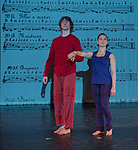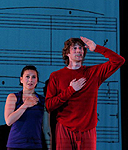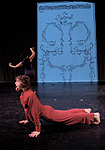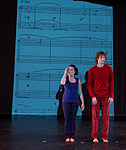|
 Musicians have an advantage over dancers—they can
have the music in front of them while they play. Musicians have an advantage over dancers—they can
have the music in front of them while they play.
 Throughout the history of
dance, so-called “brilliant” innovators have attempted to remedy this lacuna by inventing various forms of dance notation. None of them have been completely successful—until now! Throughout the history of
dance, so-called “brilliant” innovators have attempted to remedy this lacuna by inventing various forms of dance notation. None of them have been completely successful—until now!
 On the never-to-be-forgotten date of June
something-or-another, Dudley Brooks revealed an invention that will completely transform the future of dance. On the never-to-be-forgotten date of June
something-or-another, Dudley Brooks revealed an invention that will completely transform the future of dance.
 Mr. Brooks first showed the inadequacy of
the exsting forms of dance notation by having two dancers attempt to sightread a Renaissance dance, a Baroque dance, a Romantic-era dance, and a 20th-century classic. Needless to
say, the creators of these dances would have been horrified by how badly their conceptions were represented. Mr. Brooks first showed the inadequacy of
the exsting forms of dance notation by having two dancers attempt to sightread a Renaissance dance, a Baroque dance, a Romantic-era dance, and a 20th-century classic. Needless to
say, the creators of these dances would have been horrified by how badly their conceptions were represented.
 Mr. Brooks then introduced his remarkable new form of
notation, so simple and so obvious that even a volunteer from the audience who had never danced before was immediately able to partner an experienced ballerina in the heretofore challenging Grand Pas de Deux from Sleeping Beauty.
This impressive feat was made easier by the use of ingenious reading helmets designed by Mr. Brooks. Mr. Brooks then introduced his remarkable new form of
notation, so simple and so obvious that even a volunteer from the audience who had never danced before was immediately able to partner an experienced ballerina in the heretofore challenging Grand Pas de Deux from Sleeping Beauty.
This impressive feat was made easier by the use of ingenious reading helmets designed by Mr. Brooks.
 Despite a few tiny glitches—upside-down scores,
missing pages, the fact that the reading helmets made the dancers blind to anything except their scores—the concert proved that Mr. Brooks has indeed left a huge mark on the world of dance! Despite a few tiny glitches—upside-down scores,
missing pages, the fact that the reading helmets made the dancers blind to anything except their scores—the concert proved that Mr. Brooks has indeed left a huge mark on the world of dance!
|